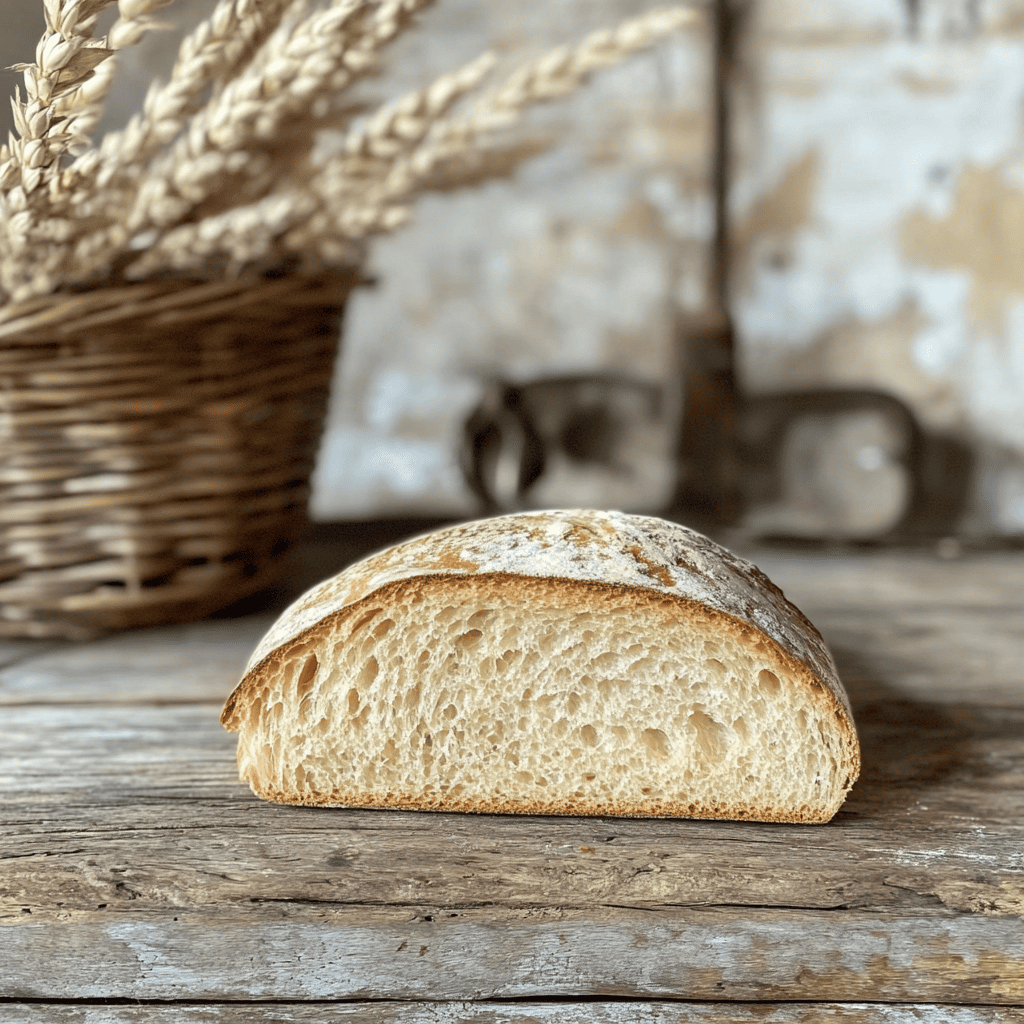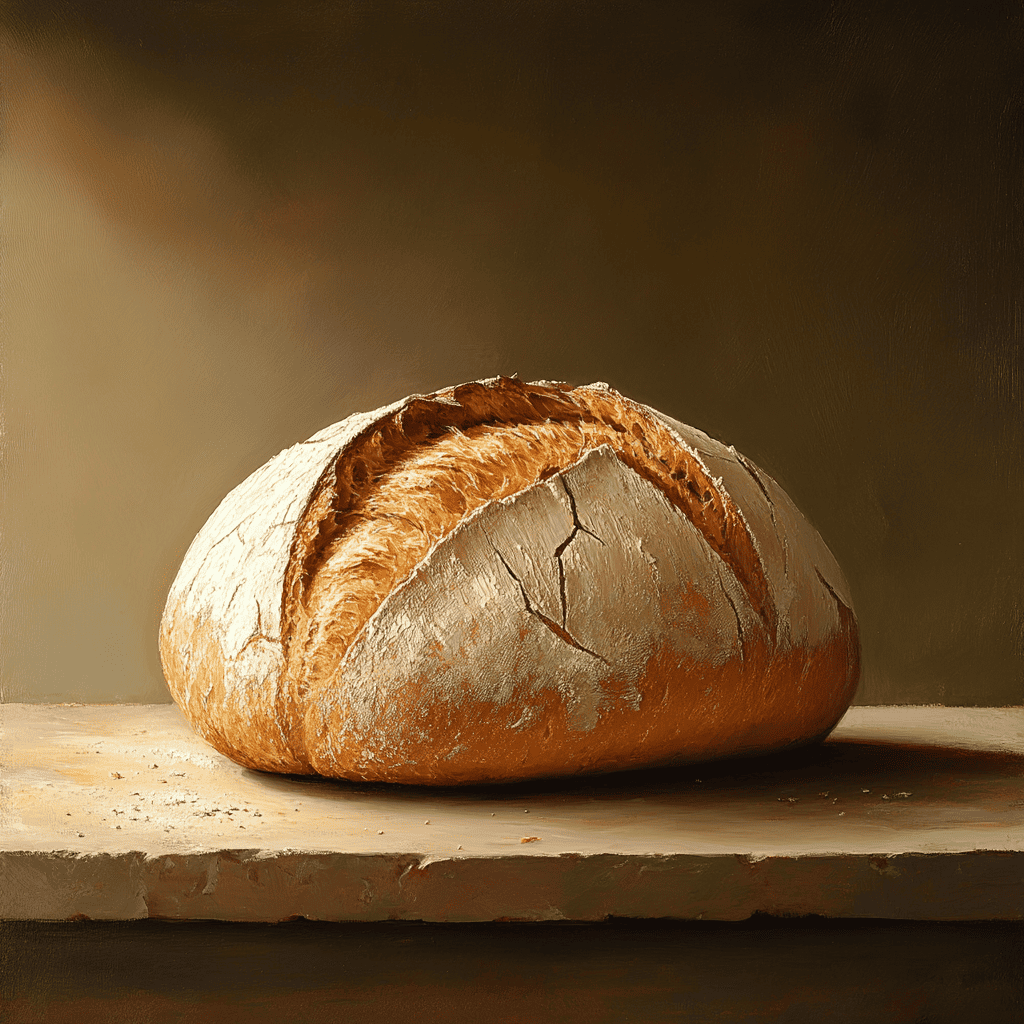MIRACLE BREAD
No-Knead Bread Miracle: The Quick and Easy Recipe
Introduction
The no-knead “miracle bread” has revolutionized the way we make bread at home, combining ancient tradition with modern techniques. But how did this recipe come about? Why is it so popular today? Does it really work without kneading?
In this article, we’ll explore:
The historical origins of no-knead bread.
The science behind its perfect texture.
Frequently asked questions (and their answers).
Expert secrets for mastering it.
Conclusion : Is it worth the hype?
Homemade bread is a true pleasure, but for many, preparing it seems like a complicated task, especially when it involves kneading for long minutes. This is where no-knead “miracle bread” comes in! This bread will become a favorite for those who love homemade bread but don’t have the time or inclination to knead the dough. Simple to make, with minimal effort and maximum flavor, it’s perfect for any occasion, from everyday meals to brunches with friends.
In this article, we explain how to make this miracle bread, with simple steps, tips, and tricks to ensure success.

A Detailed History of No-Knead Miracle Bread: From Tradition to Homemade Revolution
No-knead bread, known today as “miracle bread” for its simplicity, has roots intertwined with the history of baking itself. Its evolution reflects the human quest for practical methods without sacrificing flavor. Here we tell you about its fascinating history:
Ancient Origins: The First “Effortless” Breads
- Primitive civilizations (10,000 BC) : The first breads were rudimentary mixtures of ground grains and water, left in the sun or near a fire. The Egyptians, upon discovering accidental fermentation (2000 BC), noticed that the leftover doughs swelled on their own.
- Roman campaign bread : Roman soldiers mixed flour with water and salt, cooking it over a fire without kneading. Similar to “panis militaris ,” the precursor to modern rustic bread.
Middle Ages: Simplicity in Homes
In medieval Europe, peasants and monks developed recipes for slow-fermented breads:
- “Abandoned sourdough” bread : They let the dough rest for days in cool places (such as cellars), taking advantage of natural yeasts.
- Jewish influence : Challah (Jewish ceremonial bread) was sometimes made with minimal manipulation, prioritizing fermentation.
20th Century: The “No-Knead Bread” Revolution
The real turning point came in 2006 with Jim Lahey , owner of a bakery in New York:
- Scientific experiment : Lahey demonstrated that a very moist dough (80% hydration) and 18 hours of cold fermentation produced a bread with perfect alveoli, without kneading.
- Publication in The New York Times : Her recipe went viral, democratizing artisanal bread in homes. The French press dubbed it “pain miracle . “
Keys to its Global Popularity
- Adaptability : Perfect for urbanites without time.
- Science behind simplicity : Slow fermentation develops gluten without physical effort.
- Social media : In 2010-2020, blogs and YouTube popularized versions with a cocotte (iron pot), inspired by professional ovens.
Fun Facts
- Mexico : In rural areas, country bread is prepared with an overnight rest, similar to the modern method.
- Slow food culture : Gastronomic movements have adopted it as a symbol of conscious cooking.
Why “Miracle”?
The name captures the surprise of achieving a professional bread with:
- 3 minutes of mixing .
- Accessible ingredients .
- Zero specialized technique .
Legacy : Today, this bread combines ancient tradition with innovation, proving that patience (not strength) creates masterpieces. Every home can now be its own bakery!

Basic Ingredients for Miracle Bread
The popularity of this bread lies in the fact that it only requires basic ingredients:
- 500g of flour (type 55 or 65, but you can mix whole wheat or rye flour for more flavor).
- 1 sachet of active dry yeast (or 15 g of fresh yeast).
- 10 g of salt .
- 350 ml of warm water (about 40°C).
- 1 tablespoon of sugar (or honey).
- 1 tablespoon olive oil (optional, for greater flexibility of the dough).
Simple Steps to Make Miracle Bread
- Prepare the yeast.
In a large bowl, pour the warm water and add the yeast and sugar. Mix well and let it sit for 10-15 minutes until foamy (this activates the yeast). - Mix the dry ingredients.
In another bowl, combine the flour and salt. Optional: add herbs, seeds, or nuts (rosemary, sunflower seeds, etc.). - Add the yeast.
Pour the activated yeast mixture into the dry ingredients. Mix with a wooden spoon until you have a sticky dough (don’t worry about the texture!). - Rest the dough.
Cover the bowl with plastic wrap or a cloth and let it rest for 1-2 hours at room temperature (or overnight in the refrigerator for a more intense flavor). The dough should double in volume. - Forming the Bread:
Preheat the oven to 220°C (420°F) with a Dutch oven or baking sheet inside. Dust your hands with flour and shape into a ball or loaf without kneading. - Bake:
Place the dough in a hot pan/dish. Cover the pan if it’s cast iron. Bake for 30-40 minutes, until golden brown and hollow when tapped. - Cool
Let the bread rest on a wire rack before slicing (although it’s tempting to eat it warm with butter!).
Secrets of the Miracle Bread
- Moist dough : Key to an airy crumb.
- Long rest : More flavor and better texture.
- Cooking in a closed pot : Achieves a crispy crust and tender crumb (use a container with water if you don’t have a pot).
Personalization
- Seeds/Nuts : Adds texture (sesame, walnuts).
- Herbs : Rosemary, thyme or garlic powder.
- Whole wheat bread : Replace part of the flour with whole wheat or rye.
- Sweet version : Add raisins, chocolate or cinnamon.
Key Tips
Use warm (not hot) water to avoid killing the yeast.
Don’t add too much flour: the dough should be sticky.
Adjust the baking time according to your oven.
Frequently Asked Questions (FAQ)
1. Why don’t you have to knead this bread?
The key is in slow fermentation :
- Gluten develops naturally with rest (12-24 hours).
- The CO₂ bubbles created by the yeast provide structure without the need for kneading.
2. Can I use natural yeast (sourdough)?
Yes! Replace commercial yeast with:
- 100g active sourdough starter (reduce water by 50ml).
- Ferment for twice as long (24+ hours in the refrigerator).
3. Does it work without a cast iron pot?
Proven alternatives:
- Pyrex pot (resistant to high temperatures).
- Tray with water below (to generate steam).
- Stone oven (if you are lucky enough to have one).
4. Why does it sometimes become gummy?
Common mistakes:
- Excess flour when shaping (dough should be sticky!).
- Underbaked (use a thermometer: it should read 90°C internally).
5. Can it be frozen?
Yes, but with a trick:
- Slice before freezing.
- Toast directly from the freezer (it’s like freshly made).
Extra Fun Facts
- Guinness World Record : In 2018, a Turkish baker made the “world’s largest no-knead bread” (85 kg!).
- In space : NASA studied this method for fresh bread on space missions (without gravity, kneading is impossible).
- Vegan version : Replace the honey with maple syrup (works just as well!).
Texture and Flavor
- Texture:
- Very spongy, soft and moist interior , with an airy crumb thanks to its short but effective fermentation.
- Slightly crispy crust , but not as hard as that of a traditional rustic bread.
- It doesn’t require kneading, but the steam generated during baking gives it a texture similar to professionally baked bread.
- Flavor:
- Smooth, neutral and slightly sweet flavor , perfect for both savory and sweet dishes.
- Depending on the type of flour (whole wheat, white, spelt), the flavor can vary: from more delicate to more robust and earthy .
- It can be customized with herbs, cheese, seeds or spices to give it a special touch.
Consumer Context
- Ideal for breakfast, snacks or to accompany main dishes .
- Very popular in homes looking to make homemade bread without kneading or special tools .
- It became a viral recipe during the pandemic because it was easy, economical, and delicious .
- Perfect to eat freshly made with butter, jam, avocado or cold cuts .
Visual Aspect
- Rounded shape, with irregular cracks on the surface due to baking in a closed pot or mold.
- Golden, rustic, artisanal-looking crust.
- The interior (crumb) shows medium bubbles and light texture .
- It can be dusted with flour on top before baking for a traditional rustic effect .
Curiosities
- It is called “ Miracle Bread ” because it requires no kneading or long fermentation , and yet it turns out incredibly fluffy.
- It is often baked in a closed pot or mold (such as a casserole dish or Pyrex with a lid) , which simulates the steam effect of a professional oven.
- It was popularized by cooking blogs and forums as a foolproof recipe for beginners .
- It can be made in less than 2 hours from start to finish.
Estimated Nutritional Value (per serving of approximately 60 g)
(Approximate values for traditional version with white flour)
- Calories: 150 – 180 kcal
- Fats: 1 – 3 g
- Carbohydrates: 30 – 35 g
- Sugars: <1 g
- Protein: 4 – 6 g
- Fiber: 1 – 2 g
- Sodium: 200 – 300 mg (depending on added salt)
- Free of preservatives and additives
Other Interesting Information
- It can be made with whole wheat flour, gluten-free flour, or special blends for dietary needs.
- It can be frozen once baked and easily reheated.
- Adding seeds, nuts, or olives to the interior makes it a more gourmet version.
- It is ideal for teaching children or beginners the basic principles of bread making.
- Cooking in a closed pot creates a kind of “micro-steam oven” that greatly improves the texture.

Conclusion
This no-knead bread is the perfect solution for enjoying homemade bread with minimal effort! With simple ingredients and these tips, you’ll have a golden, fluffy loaf with a perfect crust. Ideal for beginners and experts alike.
Advantages
- Accessible : Ideal for beginners or those who do not have a mixer.
- Tasty : Slow fermentation enhances complex aromas.
- Versatile : From rustic bread to versions with olives or chocolate.
Disadvantages
- Patience required : It is not fast (although active work is minimal).
- It depends on the oven : Some ovens do not distribute heat well.
Final Verdict
No- knead miracle bread isn’t magic… it’s science! It combines microbiology (fermentation) and physics (steaming) to achieve professional results. If you’re looking for artisanal bread without the physical effort, this recipe is a gem . But if you prefer bread that takes just one hour, use traditional methods instead.
Final Tip : Write down your adjustments (times, flours) in a notebook. Every oven and climate affect the result!
Enjoy this easy and delicious bread!

